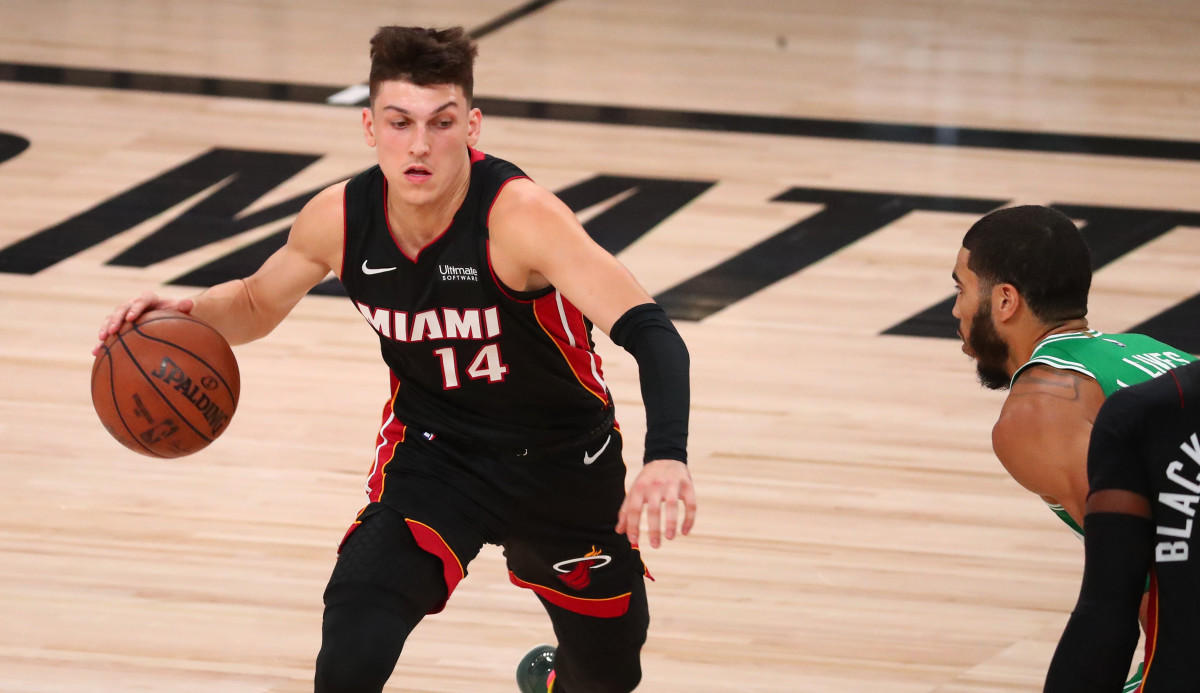Heat Check: The Story of Tyler Herro's Earned Confidence
LAKE BUENA VISTA, Fla. – Marcus Smart stood, hands on hips, looking off to his left at the big screen in The Arena. A man gets one angry rant per series, perhaps per postseason, and Smart had used his after Game 2. There was nothing he could do now, no way to save his team from Tyler Herro.
Twenty years old, thirty-seven points. What Herro did to Boston here Wednesday, to give the Miami Heat a 3-1 Eastern Conference Finals lead, left people searching for comparisons: Who had shot so well, so young, in such a big game? But Andre Iguodala has seen this before. He has watched Herro in practice with the Heat, at Kentucky, and even before that: “You go back and watch him in high school, middle school, he’s always had that edge to him, wanting to be great.”
Tyler Herro been like that!
— ThrowbackHoops (@ThrowbackHoops) September 24, 2020
(🎥: @Ballislife) pic.twitter.com/0KtdE8Lrsw
Iguodala had seen something like this before, too. He made it to five straight NBA Finals with the Splash Brothers in Golden State. Tyler Herro is not Steph Curry. Let’s be clear about that. But some of the shots he hit against Miami had that Curry feel: Sometimes he was off-balance, but his shot was not. On one play, he dribbled quickly, like he might cross over Smart—an all-NBA defender—only to pull up and drain a three. He managed to take 21 shots without seeming to force them. He made 14.
“I won’t compare them,” Iguodala said. “But they definitely have … I’m trying for the right word. The way they can handle the ball and get into their shots, Tyler shows some resemblances there. I’m not saying they’re the same. But there are some resemblances in that he can get to his shot pocket off the dribble and off the shoot and catch, which is rare—that guys have both of those features in their games.”
Twenty years old, thirty-seven points. When Curry was 20, he put up more than 37 a few times, but one of them was against Appalachian State. Not quite the same.
The Heat beat the Celtics, 112-109, and it’s fair to say Erik Spoelstra has outcoached Brad Stevens and that the Heat have played crisper basketball with greater urgency. But we should not go overboard here. Although the Heat lead the Celtics 3-1, the difference in this series is not nearly as large as one of Tacko Fall’s toenails.
Miami’s three wins came by a total of 11 points. (The teams have actually scored the same number of points in the four games.) Spoelstra scoffed at the idea his team has controlled most of the action. It doesn’t feel that way to him. But sometimes, a close series just comes down to shot-making, especially as the series progresses and coaches run out of fresh ideas. In Game 4, Miami players not named Tyler Herro only made five of 32 three-pointers. Herro just shot Miami to within one game of the Finals.
“Herro was ridiculously good tonight,” Stevens said. “That rim must have looked like the ocean to him.”

Curry changed our idea of what a great NBA player looks like. He is not that big and will never enter a dunk contest, and there were serious questions about his defense when he came out of Davidson. But he is so skilled and such an extraordinary shooter that he became an MVP. Without Curry, Trae Young is probably not a top-five pick. Everybody wants to find the next Curry, of course, but most would be happy just to find somebody with some similar traits.
They are harder to find than you might think. Great shooting is not about who can make the most shots in an empty gym. A lot of players can do that. Truly great NBA shooters can release shots quickly, coming off screens or off the dribble, from all over the floor, often with hands in their faces—regardless of pressure, how tired they are, or how many shots they have fired up that night.
Herro has two qualities that define every great shooter. One is work ethic. The only way to refine your shot is to refine your shot. Spoelstra said, “I think everybody overestimates what you can do in a day and underestimates what you can do in months of work. He is relentless with his work ethic.” Iguodala says: “It’s just an easy cliché line, ‘he’s a hard worker,’ but he really puts his work in.”
The other quality is belief. For all the cross-franchise friendships and talk about a brotherhood, the NBA is no place for a kid. It’s a physical league, and every minute of playing time is precious.
“He has a lot of confidence and in this league, confidence is something that isn’t factored in a lot of times,” Iguodala said. “You can’t analyze guys’ confidence. It won’t show up anywhere on the stat sheet. You can’t calculate it.”
When it is real, though, you can see it. Herro has the confidence borne of hard work; he had not scored 37 points in a crucial playoff game, but he knew he could, even though he didn’t set out to do it. He badly missed a three-pointer with 3:34 left and the Heat clinging to a five-point lead, but it did not faze him.
Herro talked afterward about people questioning him at every step, from Kentucky to the NBA: “Nobody thought I would survive there. Nobody thought I would survive here.” It was manufactured disrespect. Kentucky beat Kansas in a recruiting war for him. It’s clear now that he should have gone higher in the 2019 draft, but he went 13th after a single college season. It’s not like he went undrafted.
The point, though, is not that people questioned Herro at Kentucky or when he left for the NBA; it’s that he saw two snake pits and jumped right in. Twenty years old, thirty-seven points, and not one of those points surprised him.
